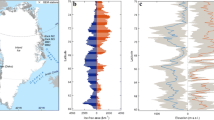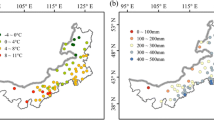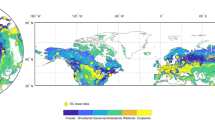Abstract
Recent climate warming has altered plant phenology at northern European latitudes, but conclusions regarding the spatial patterns of phenological change and relationships with climate are still challenging as quantitative estimates are strongly diverging. To generate consistent estimates of broad-scale spatially continuous spring plant phenology at northern European latitudes (> 50° N) from 2000 to 2016, we used a novel vegetation index, the plant phenology index (PPI), derived from MODerate-resolution Imaging Spectroradiometer (MODIS) data. To obtain realistic and strong estimates, the phenology trends and their relationships with temperature and precipitation over the past 17 years were analyzed using a panel data method. We found that in the studied region the start of the growing season (SOS) has on average advanced by 0.30 day year−1. The SOS showed an overall advancement rate of 2.47 day °C−1 to spring warming, and 0.18 day cm−1 to decreasing precipitation in spring. The previous winter and summer temperature had important effects on the SOS but were spatially heterogeneous. Overall, the onset of SOS was delayed 0.66 day °C−1 by winter warming and 0.56 day °C−1 by preceding summer warming. The precipitation in winter and summer influenced the SOS in a relatively weak and complex manner. The findings indicate rapid recent phenological changes driven by combined seasonal climates in northern Europe. Previously unknown spatial patterns of phenological change and relationships with climate drivers are presented that improve our capacity to understand and foresee future climate effects on vegetation.
Similar content being viewed by others
Avoid common mistakes on your manuscript.
Introduction
Consistent estimates of plant phenology over continuous spatial and temporal domains are essential for quantifying climate change impacts on ecosystems (Walther et al. 2002; IPCC 2014) and for understanding the mechanistic basis of phenology (Pau et al. 2011) and interactions among involved biotic and abiotic factors (Richardson et al. 2013). Many studies based on direct human observations of vegetation have indicated strong phenological responses to climate during recent decades (Fu et al. 2014a; Menzel et al. 2006; Chmielewski and Rötzer 2001). For example, across Europe, the advancement of spring phenology matched the warming pattern during 1971–2000 (Menzel et al. 2006). Over western Europe, continued advancement of the start of the growing season (SOS) has been observed, including the two recent decades (Fu et al. 2014a).
Satellite observations are invaluable for complementing these point scale studies and investigating broad-scale phenology variations, allowing for regional and global studies of climate impact and sensitivities. However, several recent studies of spring phenology based on satellite data have produced inconsistent results. For example, Fu et al. (2014a), using the normalized difference vegetation index (NDVI) from the Advanced Very High-Resolution Radiometer (AVHRR) Global Inventory Modeling and Map** Studies (GIMMS) dataset, showed a delayed SOS during 2000–2011 in western Central Europe, indicating a reversal of the 1982–1999 advancement. Furthermore, Wang et al. (2015b), who examined SOS over the northern hemisphere using NDVI datasets from different satellite sensors, found inconsistent SOS trends depending on satellite platforms. Other studies based on GIMMS NDVI suggested that the northern hemisphere SOS advancement had weakened or even reversed in the 2000s compared with its trend in the 1980s and 1990s (Jeong et al. 2011; Barichivich et al. 2013). These inconsistencies indicate considerable uncertainties in the remotely sensed phenology estimates, caused by, e.g., large inter-annual variations, short time periods, missing data, and inability of commonly used vegetation indices to correctly handle snow conditions and dense northern forest canopies (Huete et al. 2002; Delbart et al. 2005; Jönsson et al. 2010).
Air temperature is the main climatic factor regulating the onset of plant growth at boreal and temperate forests, including direct regulation by spring warming accumulation for bud burst and indirect regulation by winter chilling accumulation for bud rest break (Hänninen 2016). However, many studies have reported inconsistent spring phenology temperature sensitivities using different data sources, e.g., warming experiments (Wolkovich et al. 2012), ground phenological observations (Wolkovich et al. 2012; Menzel et al. 2006; Chmielewski and Rötzer 2001), and satellite observations of land surface greenness (Piao et al. 2006). Precipitation during winter and spring has also been found to affect the spring phenology in a complex manner at northern middle and high latitudes (Fu et al. 2015a, b; Piao et al. 2006; Cong et al. 2013; Yun et al. 2018). Environmental conditions during the previous year have a legacy effect on spring events of the next year: the warming-promoted summer growth and primary production will carry over into other seasons (** from MODIS: algorithms and early results. Remote Sens Environ 83(1–2):287–302. https://doi.org/10.1016/S0034-4257(02)00078-0 " href="/article/10.1007/s00484-019-01690-5#ref-CR16" id="ref-link-section-d22316313e661">2002). WET, wetland; ENF, evergreen needleleaf forest; DBF, deciduous broadleaf forest, shrubland, and mixed forest; CRO, cropland and grassland
Satellite data and phenology retrieval
The MODIS MCD43A4 NBAR dataset (Collection 5, Schaaf et al. 2002) at 500-m resolution and 8-day interval was used to compute the PPI for the period of 2000 to 2016 over the study area. The PPI was formulated using the difference between near-infrared reflectance (NIR) and red reflectance (red):
where DVI is the difference vegetation index (DVI = NIR − red). DVImax represents the maximum DVI of a pixel. K is a gain factor depending on vegetation structure, diffuse fraction of solar radiation and sun zenith angle. (For details of PPI, see ** and Eklundh 2014). PPI has been shown having a linear relationship with green leaf area index and strong correlation with gross primary productivity, and is a useful proxy for vegetation growth dynamics (** and Eklundh 2014). The raw PPI data were smoothed with double logistic fitting using the TIMESAT software (Jönsson and Eklundh 2004). Based on previous studies (** et al. 2017; Karkauskaite et al. 2017), the thresholds for SOS and EOS (end of growing season) were set at 20% of the mean 17-year amplitude of a pixel. The phenology metrics from 20% PPI threshold have been shown to be in good agreement with those derived from carbon flux towers and direct phenology observations (** et al. 2017). In this study, we only focused on SOS trends and climate sensitivities. The EOS was used to divide the climate variables in the full annual cycle before the average SOS into three periods: spring—the 3 months preceding the SOS; winter—from the previous EOS to the beginning of spring; and summer—the growing period from the SOS to the EOS. Since the three periods were determined from the 17 year’s average phenology of a pixel, the window period was the same for all years of the pixel and different among pixels. The phenology-based three-season division (no autumn) was determined from the partial correlation of the SOS to the climate of the individual month before the average SOS (Suppl. Material Fig. S1) and differs from a calendar-based four-season division. The direct effect of spring temperature and precipitation on SOS and the legacy effects of these climate variables (Gordo and Sanz 2010) during previous winter and summer were all investigated in this study.
Climate data and analysis
The gridded daily mean temperature data at 0.22° resolution from ENSEMBLES gridded observational dataset (E-OBS, version 16.0, Haylock et al. 2008) generated by the European Climate Assessment & Dataset project (https://www.ecad.eu/) were used in this study. The precipitation data in the E-OBS are incomplete over our study region and period; therefore, we instead used the NOAA CPC (Climate Prediction Center) unified gauge-based analysis of global daily precipitation from US National Center for Atmospheric Research (NCAR, ftp://ftp.cdc.noaa.gov/Datasets). We resampled the NCAR precipitation data from 0.5° to 0.22° resolution using bilinear interpolation to match the E-OBS grid size. We then calculated the mean temperature and total precipitation for each of the three periods for the years 1999 to 2016. Only the winter and summer periods were calculated for 1999, and only the spring period for 2016, so as to relate these climate variables to the SOS from 2000 to 2016 using panel data analysis. These climate variables had some temporal tendencies in the 17 years, but in general, there were no significant trends (Suppl. Material Fig. S2 and Table S1).
Satellite data analysis
We used the fixed-effect panel analysis technique (Hsiao 2003) to estimate SOS trends, climate sensitivities, and partial correlations between SOS and climate variables in the periods before the mean SOS. In panel analysis, data of many independent pixels within a predefined area are pooled together to increase the sample size and obtain stronger statistical inference. Panel data regression is not a simple regression on pooled data; instead, it is a multivariate regression on a common slope for all pixels and different intercepts for individual pixels. The pixel-specific intercept from the fixed effect accounts for heterogeneity within the panel that is not explained by the common slope.
Here we pooled 17-year SOS time series of all MODIS pixels (500-m pixel size) within a climate grid (0.22° pixel size, non-overlapped and covering about 3000 pixels on average) to estimate SOS trend, climate sensitivity, and SOS-climate partial correlation. The sensitivity was determined as the changes in SOS per unit change in climate factors from a linear model on the first-order differences of variables following Zhou et al. (2001), so as to avoid exaggerated statistical significant relations from spurious regression (Granger and Newbold 1974). The partial correlation was also estimated on the first-order differences of variables to avoid spurious correlation. The panels covering less than 20 valid MODIS pixels (non-vegetated area) were excluded from further processing. Ordinary least squares (OLS) regression was used to estimate the slope from the panel data, which gave the phenology trend (or sensitivity) of the panel. The significance level of the slope was estimated from heteroscedasticity and autocorrelation-corrected variance of the slope (Wooldridge 2010; Baltagi et al. 2011). The overall slope of the studied region was summarized from a meta-analysis of the slopes using the variance-weighted least squares method (Becker and Wu 2007). (For further information about the data analysis, see Suppl. Material).









